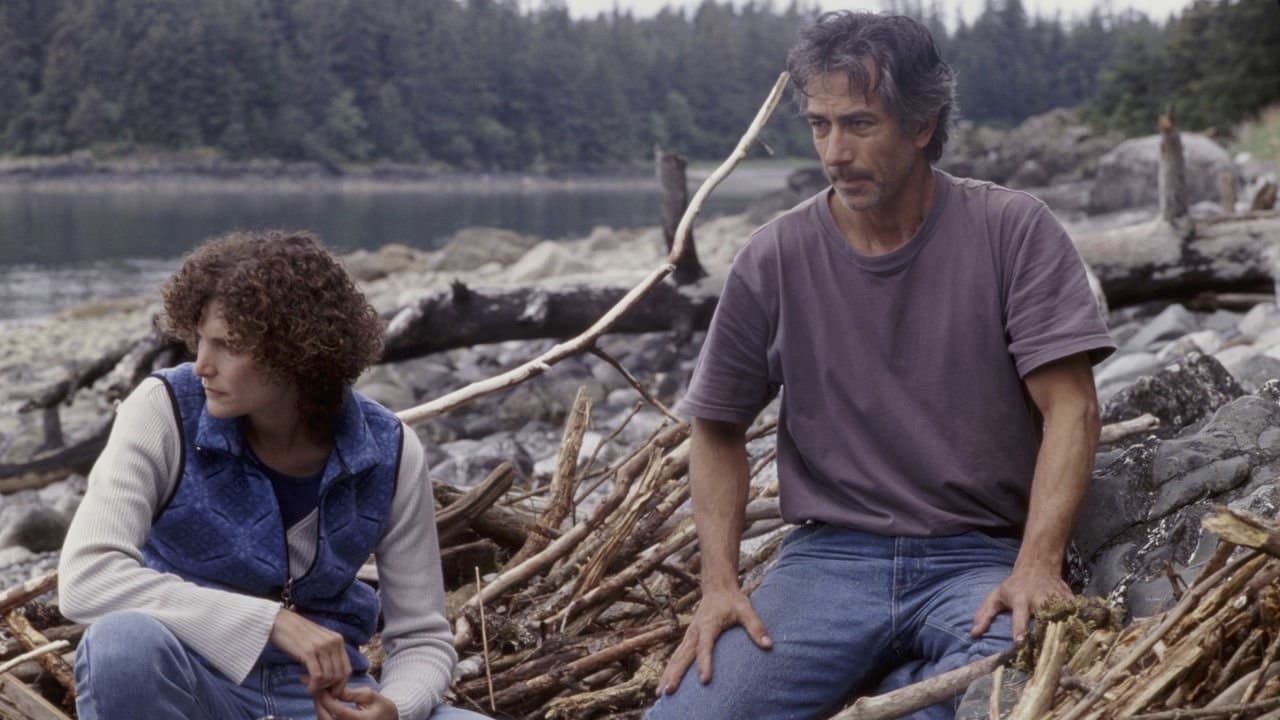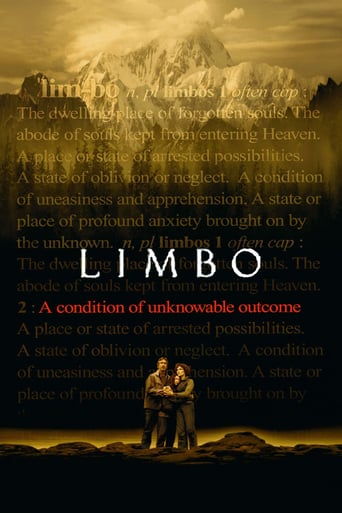tieman64
"Into a limbo large and broad, since called The Paradise of Fools, to few unknown." – John Milton This is one of John Sayles' best film. All the usual John Sayles flaws are here – a rather plain aesthetic, shallow socialism, dated radicalism etc – but these should be overlooked. The actual narrative structure of the film is genius.Sayles opens on a school of fish, closely packed and teetering on the brink of suffocation. Later we will see them flopping about, dying on dry land. Their plight is mirrored to the inhabitants of small town Alaska, who face job cuts, the effects of mechanization and the encroachment of big tourist and logging companies. Like the fish, everyone here is slowly going extinct, their natural environment changing. This leads to several characters "evolving" different means of survival. These means of survival will get more desperate and violent as the film progresses, characters switching jobs, turning to trafficking drugs, murder etc. In other words, everyone in "Limbo" is caught in some form of limbo, Sayles documenting the lengths people will go in order to break free of their uncertainty (and to inject some modicum of hopefulness into the circumstances they find themselves).The film focuses on three characters: an ex fisherman, a club singer called Donna, and her daughter. "Suffocation" or "drowning" motifs orbit around each of them. For example, the ex fisherman lost his friends/family in a drowning accident, an event which put his own life in stasis. Likewise, not only is Donna's own career in limbo, the woman teetering between unemployment and stardom, but the status of her romantic life is always intermediate, the film opening with her being dumped by yet another boyfriend.As the film progresses, Donna and the fisherman will strike up a relationship, each rescuing the other from limbo. But this relationship, and their very survival, will then be swiftly called into question, as they're eventually marooned on an island. Throughout the film, individuals, corporations, couples, loners etc are all pushed onto a kind of precipice of uncertainty, always trapped between rescue/survival and death/extinction.The film's first half is radically different from its second half. In the first half, Sayles uses a multi-threaded narrative in which we're bombarded with information and characters. This is Altman territory, Sayles forcing us to tease out fragments of plot, the director relishing our confusion. We have no idea who our lead characters are, or what indeed the film is about.Nevertheless, important information is being conveyed here. A narrator welcomes us to "America's last frontier" and praises the country's natural wonders, but Sayles' ironic imagery conveys the opposite, treating us to images of Alaska's eradication, men in tacky animal suits, tourists lining up for tickets, and a barrage of inauthentic, cheap, tourist goods. Alaska's "real" nature is being bulldozed, and with it all "authentic experience".As tourists descend upon Alaska, Sayles links them to dying salmon caught in nets and later dead fish hurling along conveyor belts. While this is going on, businessmen in charge of logging companies and tourist boards discuss things. "We want to develop themes here," one says, speaking of his desire to set up little tourist theme parks. As he talks, assistants and servants dance about, tending to his every need. But these businessmen will be swiftly discarded in favour for "the real Alaskan experience", Sayles focusing on a group of characters marginalised by gender, sexuality, race, age, economics etc. These characters, most of whom are disadvantaged, use a variety of different tactics to subvert or use to their own benefits the discourses at work around them. Their "little battles" are then morphed into the plight of three characters, the fisherman, Donna and her daughter, who find themselves stranded on an island. Existing off the tourist footpaths, this is the real "Alaska experience" ("People pay money to go on trips like this!"), the trio fighting off both wild nature and human competition.The island the trio find themselves on is called "Kuleshov Island". We recall Russian film theorist Lev Kuleshov's "Kuleshov effect", in which an audience is allowed to imbue "blank" images with their own "story", "emotions" and "effects". Kuleshov himself made a film, very similar to "Limbo", titled "By The Law", in which a group are stranded in Alaska and share a cabin in the wilderness. What Sayles does is use the "Kuleshov effect" to position the audience such that we resolve the film's story. Will our trio be rescued, or will they be sold out by a character called Smiling Jack (his name is itself suggestive of either benevolence or fiendish scheming - we choose)? Mirrored to this uncertainty is the film's embedded narrative. Here, Donna's daughter finds the diaries of a little girl who herself died on Kuleshov Island. This story-within-a-story is narrated by Donna's daughter who, when she reaches the diaries incomplete end, completes the story herself by imagining/constructing the rest of the plot. In other words, she completes the girl's fate as we complete the fate of the current Kuleshov trio.So what we have is an ensemble (society) which is bulldozed to make way for the "modern experience", a simulacrum of a dying "reality". This abstraction is reversed by a fable-like story in which a small fragment or representation of society fight for survival on an island. Here, a trio symbolically battle over their fate (the fisherman's a dour realist, Donna's a blind optimist and the daughter is an artist/dreamer). Kuleshov style, their fate is then left up to us. This, of course, like Sayles other "implicative narrative" ("Passion Fish"), directly implicates us in their plight, and enfolds us into the film. We, and cinema, are a part of the problem and a part of the solution.8.5/10 – Sayles trades literal sermonizing for something more abstract. Ignore the film's many flaws. What Sayles is doing here is very rare. Worth two viewings.
bobsgrock
John Sayles, one of the founders of American independent cinema, gives a terrific and engrossing story every time he makes a film. After seeing his take on the small-town Texas persona in Lonestar, I was prepared to see Limbo. I was not prepared for how it would affect me.This is, quite simply, a masterful work of cinema and narrative. Unlike most directors, Sayles is brilliant and relentless in his purpose. He takes his time to set up the plot, diving right into the strange, shapeless lives of a group of fishermen and natives in Port Henry, Alaska. Everyone in town is forced to reminisce in one way or another. The town is suffering financially, and the way Sayles has his camera almost sneak up and hide behind characters in order to listen to what the locals are saying is genius.Of course, typical Sayles, the plot is almost completely unpredictable. It begins, like Lonestar, as a detailed look into the lives of a small Alaskan fishing town with the lonely, drifting lives of the inhabitants taking front stage. Then, midway the plot completely shifts gears and we get a tale of man vs. nature, the elements that threaten to destroy and overtake the fighting spirit of people. It is here that the cast truly shines. David Straitharin, Mary Elizabeth Mastrantonio and Vanessa Martinez are equally fantastic in their respective, so much so that it is impossible to imagine any other actor playing any of these parts. Sayles is masterful at casting and he proves that here unlike anything else he has done. The final third of the film rests heavily on the relationship between these three characters, so it is crucial that they relate well together and be believable. I couldn't ask for three better performances.In the end, this film is completely stamped with the unique style of John Sayles. Because he is so unpredictable, it is a truly satisfying feeling after seeing one of his films. You feel, not jilted and tricked like most films do, but happy and understanding what and why things happened. This is certainly a film I will be thinking about for awhile after seeing it and I can only hope that filmmakers like Sayles will continue to stick around. After all, these are the kind of films that need to be continued. It has soul, personality and a quality that can teach and inspire. A truly great film.
merklekranz
The first half of "Limbo" has strong character development. Unfortunately only a small number of those characters have any bearing on the remainder of the film. For example, the culture clash between the Alaskans and the tourist industry, was totally gratuitous. There is also an inordinate amount of small talk that leads nowhere. All of this could be forgiven, if once the story kicks into gear, with the mother, daughter, and David Strathairn stranded on a remote island, something happened. Unfortunately the second half in the wild, is tedious and boring. I recommend fast forwarding every time the daughter picks up the diary. All the fine acting, and beautiful scenery, cannot hide the fact that this movie is way too long for such slight material, and the conjectural ending is totally unacceptable. - MERK
snoopdavidniven
God love and protect John Sayles. Not because he hits every ball out of the park, because he clearly doesn't; but because he never lets his few strikeouts compel him to try to hit a five-run homer the next time out. In an era marked by increasingly degraded and degrading notions of "entertainment" and "storytelling" - for pity's sake, as I write this, grown adults are waxing rhapsodic over a movie about a costumed billionaire-vigilante (!!) - Sayles understands that great drama is about the people we meet every day; the places we live in and how they shape us; the things that change, and the things that remain; and above all, about the human heart in conflict with itself. In LIMBO, he takes risks with his zig-zagging narrative most filmmakers simply aren't capable of, and reaps rewards of such profundity, and richness of feeling, that most audiences are too conditioned by junk-culture to recognize, let alone appreciate them. Some viewers have felt betrayed by LIMBO's seismic shifts in tone and direction, and the elliptical ending, but even that sense of betrayal speaks to how utterly absorbing and moving his handling of his Alaska-set story is, and how unblinking his observations of his characters. (You can only feel "betrayed" if you're deeply invested in the story that's been presented, after all.) Sayles' screenplay, like his direction, is so completely free of artifice as to seem transparent - his "heroes" and "villains" are separated only by their degrees of vulnerability and weakness under pressure - and his small cast of actors are working at the height of their gifts. David Straithairn, always underrated, has never been better, and young Vanessa Martinez is a quiet revelation. You won't forget these characters, or this movie, regardless of how the ending affects you. And though you hate to jinx his thus-far phenomenal career with red-carpet hullabaloo, maybe it's time to make it official and coronate John Sayles as the greatest moviemaker of our time. He may not need or want the crown, but Hollywood certainly needs to made to cry uncle and acknowledge it.

